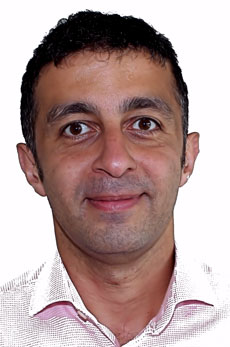Radiological method identifies hip patients who may need to be re-operated

Maziar Mohaddes, MD, PhD, University of Gothenburg University of Gothenburg
In Sweden, around 16,000 hip prosthesis operations are done annually, and about an additional 1,100 re-operations are done where part or all of the prosthetic must be replaced or removed.
Varies with age
The risk of re-operation varies with the patient’s age: around 30 per cent of patients under 50 undergo a re-operation within 15 years, while the corresponding percentage for patients older than 75 is 5-10 per cent.
The risk of re-operations also increases after each new operation on the hip joint.
Special method
Over 30 years, researchers at Sahlgrenska Academy at the University of Gothenburg have developed a special examination method that makes it possible to measure the prosthesis movement relative to the bone using high-resolution X-rays (called radiostereometry). The method, which has now been evaluated in a doctoral thesis, can be used to predict which patients are at risk of re-operation.
“With the radiostereometric method, we can discover movements in the artificial joint socket. Since these movements increase the risk that the prosthesis will loosen on the long term, the information can be used to predict re-operation,” says Maziar Mohaddes, who is presenting the studies in his doctoral thesis.
Improves the outcome
According to the researchers, the radiostereometric method can predict at an early stage if new prosthetic models and surgical techniques are safe, and if they can be expected to improve the outcome in patients.
The technique in question is so specialised that it is primarily used in research.
According to Maziar Mohaddes, broader clinical use could both identify and to some extent reduce the scope of complications in hip operations.
The doctoral thesis, which in part builds on data from the Swedish Hip Arthroplasty Register, was defended on October 2nd 2015.
Link to thesis: https://gupea.ub.gu.se/handle/2077/39540
HIP PROSTHETIC FACTS
A hip prosthesis consists of two parts: one that replaces the joint socket (the cavity on the outside of the hip bone) and one that replaces the hip joint’s femoral part. In Sweden, the parts are usually attached to the bone with the help of bone cement. But the technique is considered to be both demanding and to increase the risk of loosening, and uncemented implants are increasingly being used in Sweden and internationally.
A relatively new type of prosthesis made of the metal tantalum has demonstrated better results in scientific studies than the traditional uncemented prosthesis models.
Contact:
Maziar Mohaddes, MD, PhD, Sahlgrenska Academy, University of Gothenburg
+46-736 665 818
maziar.mohaddes@gmail.com
http://www.gu.se/english/about_the_university/news-calendar/News_detail//radiolo…
Media Contact
All latest news from the category: Medical Engineering
The development of medical equipment, products and technical procedures is characterized by high research and development costs in a variety of fields related to the study of human medicine.
innovations-report provides informative and stimulating reports and articles on topics ranging from imaging processes, cell and tissue techniques, optical techniques, implants, orthopedic aids, clinical and medical office equipment, dialysis systems and x-ray/radiation monitoring devices to endoscopy, ultrasound, surgical techniques, and dental materials.
Newest articles

NASA: Mystery of life’s handedness deepens
The mystery of why life uses molecules with specific orientations has deepened with a NASA-funded discovery that RNA — a key molecule thought to have potentially held the instructions for…

What are the effects of historic lithium mining on water quality?
Study reveals low levels of common contaminants but high levels of other elements in waters associated with an abandoned lithium mine. Lithium ore and mining waste from a historic lithium…

Quantum-inspired design boosts efficiency of heat-to-electricity conversion
Rice engineers take unconventional route to improving thermophotovoltaic systems. Researchers at Rice University have found a new way to improve a key element of thermophotovoltaic (TPV) systems, which convert heat…



